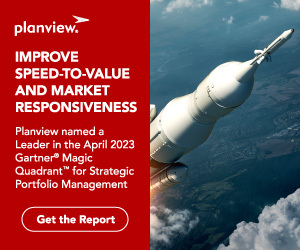If I asked you to fill in this blank: Portfolio management uses many ________ charts. You’d probably shout “bubble!” without hesitation. Indeed, frontier charts, pipeline charts, and risk vs. reward charts all effectively employ scatter and bubble charts to describe your portfolio.
But the humble bar chart is no slouch when you’re looking for portfolio insights. In this post I’ll give you two examples you might not be using today. If you already use Enrich Viewport or the Enrich Analytics Platform, then this two-minute video will explain how you can build them, too.
I often say that portfolio management is about value and balance: the value in your portfolio should be aligned with corporate goals across technology platforms, market segments, innovation levels, and even over time (short-term vs. long-term). In order to achieve those goals, the proportions of spending across these dimensions should be set with care so that you ‘place your bets’ to maximize your chances for success.
With this in mind, any chart that helps you see how much you’re spending across technologies, divisions, etc. and also how that spending aligns with anticipated value across those dimensions would be very useful indeed. Enter the contribution analysis!

With just a glance, the contribution analysis highlights both spending and value across technologies, markets, or divisions. This example, for a medicines manufacturer, is broken down by therapeutic area.
Contribution analyses display important cost and value metrics on a percentage basis so you can assess both spending and forecast returns across critical dimensions. The example above cuts across therapeutic areas for two cost metrics and two value metrics. The first two columns show costs for the current budget cycle and through project completion, making it easy to analyze spending now and into the future. The chart includes pillars for both net present value given the success of all initiatives and net present value adjusted for likely failure rates (eNPV or expected NPV), which makes it easy to see which therapeutic areas are riskier and which are less so.
By comparing the proportions of spending and value we can make quick assessments that answer the question: “Are we creating value in proportion to our spending in each division/technology/etc?” In the chart above, it’s obvious that the Dermatology division isn’t remarkable based on spending or returns. It’s also interesting that spending on Endocrine initiatives is spiking now but not in future years; CNS projects are in the opposite situation.
On a percentage basis, we expect Immunology to generate more value, based on a dollar for dollar analysis of spending, than other divisions. On the other hand, CNS spending returns are lower than any division but Ophthalmology even though it dominates total portfolio spending over the time horizon of this analysis.
As you can see, there’s a lot of insight in this one chart. Your insights will multiply further when you develop companion charts broken down by technology platform, innovation level, and region. I hope you can find a place for contribution analysis charts in your portfolio process.
Project Risk and Value Charts
There are already many ways to show project risk and value across the portfolio. If you have just a few dozen projects in your portfolio, a chart that shows both net present value and risk-adjusted net present value for each project can generate a few additional insights.

The chart above helps quickly identify high-risk and high-value projects.
Xumanase immediately stands out as a project with a very high net present value, but a much lower risk-adjusted net present value. This project may be legitimately risky, but it may also be possible to mitigate some of these risks and substantially increase its expected value.
Since the chart is sorted in descending order of eNPV, it’s easy to see that the top five projects have an almost identical eNPV, but different levels of risk. In contrast, the bottom three projects have measurable potential value, but their riskiness leads to no visible value in the chart.
With a larger set of projects, a risk vs. reward (or even eNPV vs. NPV) bubble chart might work better to show the overall portfolio, but the bar chart works well in this example because all project names are visible alongside the project metrics.
If you’d like to see how easily these charts, and hundreds of others, can be built with Enrich Analytics, take a look a this how-to video on our YouTube channel.




